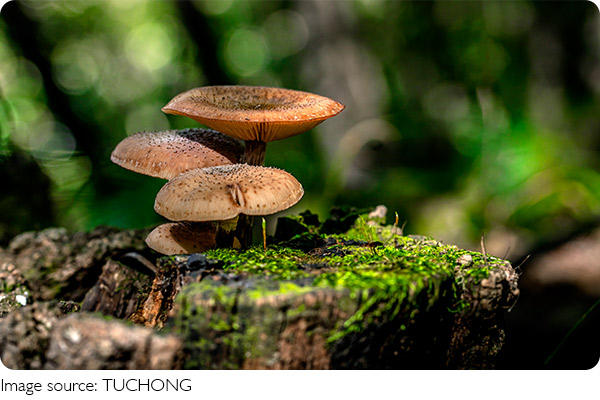More Than Mushrooms

Mushrooms are widely appreciated for their rich flavor, texture, and versatility in cooking. Often dubbed the "meat of the vegetable world," they offer more than just culinary satisfaction.
Known for their numerous health benefits, mushrooms such as the common Agaricus campestris are consumed worldwide, from Europe to North America and beyond.
In this article, we will explore the life cycle of mushrooms, their growth conditions, and the cultivation techniques that make them a widely enjoyed food. We will also dive into their nutritional value and therapeutic properties, demonstrating why they are more than just a tasty addition to meals.
The Life Cycle of Mushrooms
Mushrooms undergo two main stages in their life cycle: the mycelium stage and the fruiting body stage. The mycelium, a network of threads, spreads through the growing medium, absorbing nutrients. Over time, it forms small white nodules called primordia, which eventually develop into mushrooms.
- Mycelium Stage: This is the phase where the mushroom's mycelium grows and spreads through the substrate, whether it's organic matter like manure or sawdust.
- Primordia and Button Stage: After about 15 days of incubation, small white "buttons" appear, which will eventually grow into mature mushrooms.
- Growth to Maturity: These "buttons" expand into full-grown mushrooms, reaching maturity in a few days depending on the growing conditions.
What Makes Mushrooms Special?
Mushrooms are not just tasty; they are packed with nutrients. They provide essential amino acids, protein, and vitamins, making them a great addition to a balanced diet. Mushrooms are also known for their high water content, which contributes to their unique texture. But what sets them apart is their medicinal benefits.
Mushrooms, particularly their fruiting bodies, are rich in bioactive compounds that have been shown to support immune function, aid digestion, and even enhance mental clarity. Some mushrooms, like Agaricus, are used in traditional medicine for their ability to invigorate the spleen and improve liver function. These health benefits make mushrooms an indispensable part of both culinary and therapeutic traditions.
Growing Mushrooms: The Ideal Conditions
Mushrooms thrive in environments where temperature, humidity, and light are carefully controlled. Here’s a breakdown of the key factors that contribute to healthy mushroom growth:
- Nutrients: Mushrooms are saprophytic fungi, meaning they decompose organic matter for nourishment. Their growth medium often consists of materials like manure, corn cobs, and phosphorous fertilizers.
- Temperature: During the mycelium growth phase, temperatures of 18-20°C are ideal. However, once mushrooms begin to form fruiting bodies, temperatures should be reduced to 12-16°C for optimal growth.
- Water: Mushrooms have a high water content, and their growing medium should maintain humidity levels between 55% and 60%. Too much moisture or too little can significantly hamper growth.
- Air Circulation: Proper ventilation is crucial to ensure that mushrooms receive enough oxygen. Without sufficient air flow, they may not grow properly.
- Light: Interestingly, mushrooms do not require light to grow. In fact, too much light can hinder their development. They thrive best in dark, humid conditions.
- pH Levels: The ideal pH range for mushroom cultivation is between 6.8 and 7.5. This balance helps maintain the right environment for their growth.

Mushroom Cultivation: Techniques for Success
Successful mushroom farming requires careful preparation and attention to detail. Here's a quick guide to the essential steps involved in cultivating high-quality mushrooms:
- Choosing the Right Strain: Selecting the right strain of mushroom is crucial to ensure high yields and minimal pests. For example, strains with large fruiting bodies but lower density are often preferred for maximizing space.
- Optimizing Cultivation Techniques: Using vertical farming methods such as tiered racks with plastic netting helps to utilize space effectively. This technique also promotes better air circulation.
- Building the Growing Bed: The substrate used for mushroom cultivation is often made from materials like dry cow manure and corn cobs. After mixing, the substrate is left to ferment before being spread out in growing beds.
- Watering and Maintaining the Bed: Consistent moisture is necessary for healthy growth. The bed should be checked regularly for humidity levels and re-watered as needed.
- Harvesting and Management: Once mushrooms are fully grown, they are harvested carefully to avoid damaging the fruiting body. Proper post-harvest handling ensures that mushrooms maintain their quality and freshness.
Health Benefits of Mushrooms
Mushrooms are more than just a tasty food—they are a powerful addition to any diet. Packed with essential nutrients like proteins, vitamins, and amino acids, they contribute to overall health. Additionally, certain mushrooms have been shown to offer immune-boosting, anti-inflammatory, and antioxidant properties, making them valuable for enhancing overall health. Whether used in traditional remedies or modern dietary supplements, mushrooms have a long history of supporting health.
Mushrooms Are More Than Just Food!
Mushrooms are undoubtedly a gift from nature, offering both culinary delights and health benefits. Their versatility, nutritional value, and medicinal properties make them an essential part of many cultures. Whether you’re enjoying a mushroom risotto or using mushrooms for their therapeutic benefits, there’s no denying their impact on our health. So next time you see a mushroom, remember—it’s not just food, it's a superfood!
Mushrooms have so much to offer, and it’s the perfect time for us to explore all their delicious and nourishing possibilities. Maybe you'll toss them into a fresh salad, simmer them into a cozy soup, or layer them onto a crispy pizza. Let’s celebrate these amazing gifts from nature together—happy mushroom adventures, Lykkers!
The Mind-Blowing Benefits of 4 Mushrooms
Video by Dr. Eric Berg DC

 · Plant Team
· Plant Team